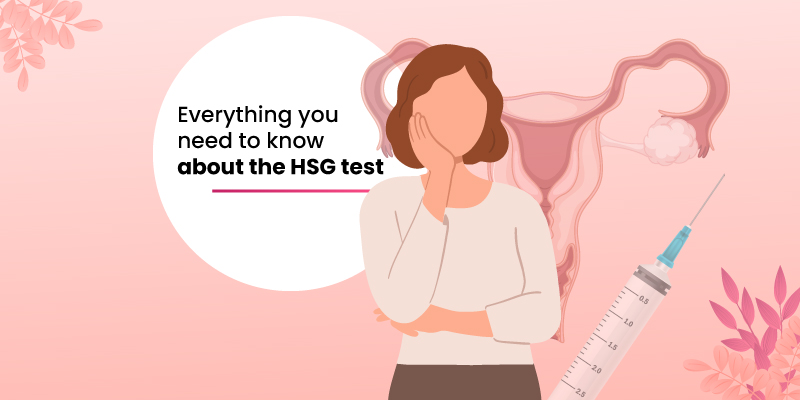Everything you need to know about the HSG test

Not being able to conceive can be mentally and emotionally stressful. A blockage in the fallopian tubes can be one of the reasons. However, medical science has made significant strides in reproductive health and it can be treated. A painless HSG test helps fertility doctors determine the cause of infertility to design a conception plan.
What is an HSG test?
Also called a Hysterosalpingogram, the HSG test is a diagnostic tool to assess the female reproductive tract. It is an efficient method to evaluate any abnormalities inside the uterus and fallopian tubes. It involves injecting a contrast dye into the uterus which upon subjected to low dose X-rays gives insights about the shape and structure of the uterine cavity and fallopian tubes.
Why is an HSG test done?
To diagnose uterine conditions:
HSG test is performed as part of the infertility diagnosis to examine the uterus for congenital uterine anomalies, fibroids, tumours, polyps, adhesions, scarring in the pelvis as these conditions might impact implantation and embryo growth.
To check the success of a tubal ligation process:
It is also done to confirm if the tubes are completely blocked after a tubal ligation procedure (a procedure wherein the fallopian tubes are tied to prevent pregnancy).
To check for blockages in the Fallopian Tubes:
Blocked fallopian tubes are one of the major causes of infertility in women. Blockages in the fallopian tubes are due to the presence of mucous, cell debris, polyps, and fibroids. These blockages won’t allow the sperm to reach the egg for fertilization or the fertilized egg can’t reach the uterus for implantation and may result in an ectopic pregnancy. These blockages in the fallopian tubes can be diagnosed with the help of an HSG test.
What to expect before an HSG test?
– It is important to know that an HSG test is scheduled between the last day of the periods and before the start of ovulation, i.e. days 5-10 of the menstrual cycle (this period might vary depending on the length of the menstrual cycle).
- Antibiotics are prescribed before the procedure, on the day of the test, and after the procedure to eliminate the risk of pelvic infections.
- It is recommended to take an over-the-counter pain reliever an hour before the procedure to help with the discomfort during the procedure.
- Inform your doctor if you are allergic to Iodine and Betadine. Contrast dyes without iodine will be used for the procedure. Also, let your doctor know in case if you are sensitive to X-rays.
- A urine pregnancy test is done before the procedure to confirm that you are not pregnant.
- HSG test is a day-care procedure and will take less than an hour to get done with it.
- Have someone to take you home after the procedure.
Step-by-Step Process of the HSG Test
HSG takes under 45 minutes from start to finish:
- The diagnostician will position you on the exam table, just like any gynaecology exam.
- They place a speculum in the vagina and insert a catheter through it to inject medication.
- Slowly contrast dye is injected till it covers the lining of the uterus and fallopian tubes.
- A radiologist takes an X-ray image to discover abnormalities or blockages that may affect the patient’s fertility.
What to expect after the HSG test?
It is important to remember that these side effects usually resolve within a few days after the procedure.
- Might experience slight discomfort in the pelvic area (If the pain persists consult with your fertility specialist)
- Abdominal pain or cramping
- Sticky vaginal discharge (due to the dye)
- Mild bleeding or spotting
- Dizziness
- Nausea
What are the risks of the HSG test?
An HSG test is relatively safe, but rare complications may include:
- An allergic reaction to the contrast dye
- Infection of the uterus and fallopian tubes
- Perforation of the uterus
- A small amount of abnormal bleeding (If it persists more than a few hours and is heavier than periods, consult with your doctor)
- Fever or chills
Is the HSG test a painful procedure?
HSG test majorly is a painless procedure and the experience may vary from woman to woman due to their respective pain tolerance levels. In a few women the procedure might cause mild discomfort. The dye is introduced painlessly through the vagina into the uterus and fallopian tubes. Few women may experience slight cramping while injecting the dye.
Over-the-counter pain medications can help in alleviating the discomfort.
Who should avoid the HSG test?
Women should avoid getting an HSG test in case of
- Pregnancy
- Pelvic inflammatory disease (PID)
- Unexplained vaginal bleeding
Interpretation of the HSG test results
Your fertility specialist will evaluate the scan images and the next steps of the treatment after the HSG test will depend on the results. If the report shows a blockage in the fallopian tubes, then a laparoscopy is done to further diagnose the problem, or IVF (In Vitro Fertilization) or IUI (Intrauterine Insemination) treatment may be recommended.
Can an HSG test improve the chances of pregnancy?
In a few cases, the HSG test may indirectly boost the chances of conception in couples. It is safe to try for almost up to 3 months after the procedure. In such instances, it is assumed that the contrast dye (iodine) used during the procedure might help in clearing out the mucous or other cell debris that could be blocking the fallopian tube and preventing pregnancy. Although it can be a pleasant side effect it is important to remember that it might not be a necessary outcome.
Is the HSG test the only option?
There are other procedures such as Laparoscopy and Hysteroscopy. They are used to diagnose problems arising due to issues in the uterine cavity but they don’t give any information about the blockages in the fallopian tubes.
HSG test is also considered in cases of recurrent miscarriages and abnormal bleeding.
FAQs
What are the do’s and don’ts for HSG test? – H3
Before the procedure, you must take only the pain medication and antibiotics prescribed by your HSG procedure diagnostician. Despite medication, you may experience cramps, dizziness, or nausea which can make driving difficult. It is best to have someone accompany you for the procedure, so you do not have to drive back home.
What is the 10-day rule for HSG?
The 10-day rule indicates that the best time for administering the painless HSG test is 7 to 10 days after the end of the last menstrual period. This is the time when the fallopian tubes are clear of menstrual debris. Additionally, the process does not interfere with the chances of the next pregnancy as there still is some time for ovulation.
Is HSG test useful for pregnancy?
An HSG test helps your doctor determine if the cause of delays in conception is a blockage in the fallopian tubes or a mass in the uterus. This helps them guide you adequately about the next steps of pregnancy.











